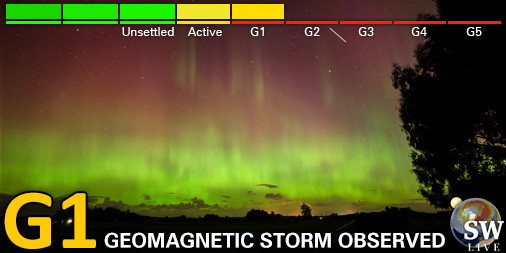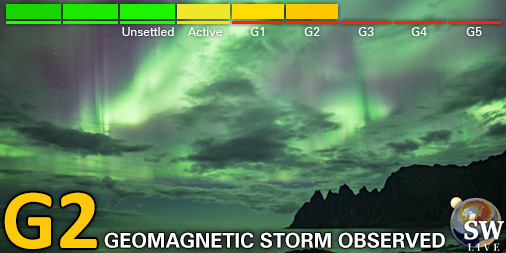Viewing archive of Wednesday, 26 October 2016
Daily bulletin on solar and geomagnetic activity from the SIDC
Issued: 2016 Oct 26 1230 UTC
SIDC Forecast
Solar flares
Quiet conditions (<50% probability of C-class flares)
Geomagnetism
Major magstorm expected (A>=50 or K>=6)
Solar protons
Quiet
| 10cm flux | Ap | |
|---|---|---|
| 26 Oct 2016 | 078 | 041 |
| 27 Oct 2016 | 077 | 034 |
| 28 Oct 2016 | 076 | 026 |
Bulletin
NOAA 2603 produced the strongest event of the period, a B1.9 peaking at 20:42UT. This region has now a mature but small trailing spot, and seems to have simplified magnetically. A strong coronal mass ejection (CME) over the northeast solar limb was observed in LASCO/C2 starting 25 October around 19:00UT. Its source was located on the farside of the Sun (old active region NOAA 2599). No earth-directed CMEs were observed.
Quiet flaring conditions are expected to continue, with a small chance on an isolated C-class flare.
Earth was under the influence of the high speed stream (HSS) from the huge coronal hole (CH). Maximum solar wind speeds near 830 km/s were recorded around 23UT on 25 October (DSCOVR), its current values now fluctuating between 670 and 750 km/s. Bz varied between -15 and +9 nT during the first half of the period, but is currently fluctuating between -6 and +6 nT. The interplanetary magnetic field (IMF) was directed away from the Sun (positive). Kp ranged from active to major geomagnetic storming, while K Dourbes ranged from quiet conditions to moderate storming.
Wind speeds are expected to remain above 500 km/s for the next two days, with periods of sustained negative Bz possible. Hence, mostly unsettled to moderate storm conditions are expected, with a small chance on another major storming interval (K-index = 7).
Today's estimated international sunspot number (ISN): 029, based on 17 stations.Solar indices for 25 Oct 2016
| Wolf number Catania | /// |
| 10cm solar flux | /// |
| AK Chambon La Forêt | /// |
| AK Wingst | 062 |
| Estimated Ap | 055 |
| Estimated international sunspot number | 018 - Based on 20 stations |
Noticeable events summary
| Day | Begin | Max | End | Loc | Strength | OP | 10cm | Catania/NOAA | Radio burst types | |
|---|---|---|---|---|---|---|---|---|---|---|
| None | ||||||||||
Provided by the Solar Influences Data analysis Center© - SIDC - Processed by SpaceWeatherLive
All times in UTC
Current data suggests there is a moderate possibility for aurora to appear at the following high latitude regions in the near future
Gillam, MB, Yellowknife, NTCurrent data suggests there is a slight possibility for aurora to appear at the following high latitude regions in the near future
Edmonton, AB, Iqaluit, NU, Saskatoon, SKNuuk
Latest news
Latest forum messages
Support SpaceWeatherLive.com!
A lot of people come to SpaceWeatherLive to follow the Sun's activity or if there is aurora to be seen, but with more traffic comes higher server costs. Consider a donation if you enjoy SpaceWeatherLive so we can keep the website online!

Latest alerts
04:15 UTC - Geomagnetic activity
Minor G1 geomagnetic storm (Kp5) Threshold Reached: 04:05 UTC
03:15 UTC - Geomagnetic activity
Moderate G2 geomagnetic storm (Kp6) Threshold Reached: 02:59 UTC
01:00 UTC - Geomagnetic activity
Minor G1 geomagnetic storm (Kp5) Threshold Reached: 00:51 UTC
Friday, 4 April 2025
23:30 UTC - Geomagnetic activity
Minor G1 geomagnetic storm (Kp5) Threshold Reached: 23:17 UTC
21:03 UTC - Hemispheric Power Index
The OVATION model predicts the Hemispheric Power Index to reach 75GW at 21:49 UTC
Space weather facts
| Last X-flare | 2025/03/28 | X1.1 |
| Last M-flare | 2025/04/01 | M2.5 |
| Last geomagnetic storm | 2025/04/04 | Kp5+ (G1) |
| Spotless days | |
|---|---|
| Last spotless day | 2022/06/08 |
| Monthly mean Sunspot Number | |
|---|---|
| March 2025 | 134.2 -20.4 |
| April 2025 | 148 +13.8 |
| Last 30 days | 130.9 -15.2 |






